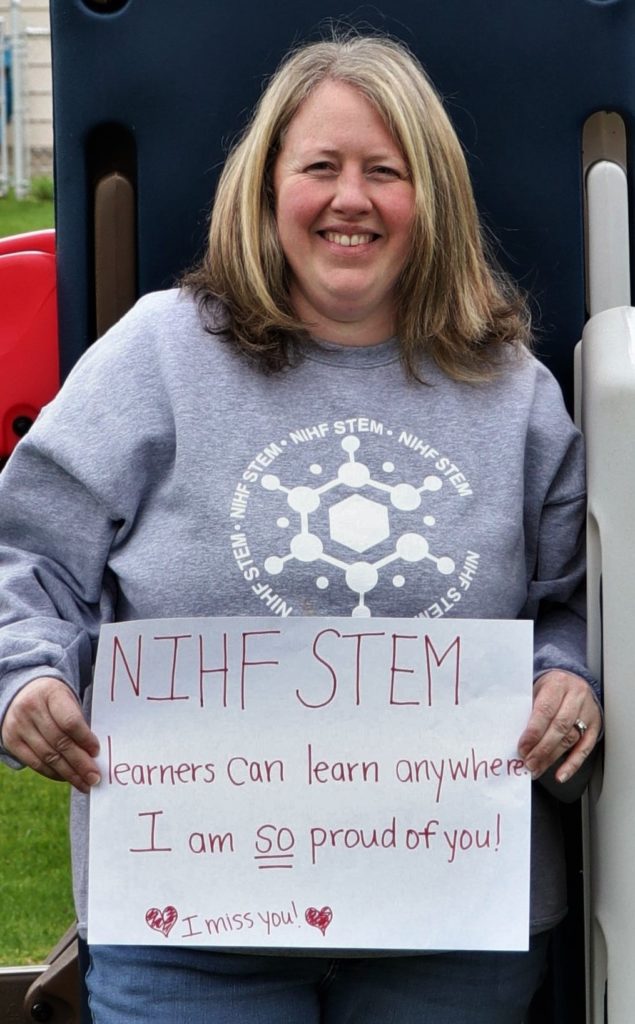During this time of academic uncertainty, students and families are faced with a diversity of daily challenges. Their new normal consists of remote learning opportunities with limited interactions to teachers and peers that help guide students’ educational success. This isolation can have negative repercussions on students’ growth and wellbeing, but many schools are trying to change that.
Akron Public Schools created a range of supports for families. Amanda Morgan, Instructional Leader for National Inventors Hall of Fame STEM Middle School, talks to us today. She’s walks us through Akron’s programs including the “Connector” initiative, a way for teachers and administrators to reach out to families and help them through this tough time.
Q: What are Akron schools doing to help foster learning during the COVID-19 crisis?

A: Akron Public Schools is focused on helping to meet all learners’ basic needs, as well as providing technology and support to successfully learn from home:
- All learners had a device to take home, including tablets for our youngest learners in preschool.
- Meals are available for pick up at school buildings throughout the district. So far, 200,000 meals have been served.
- A process was designed to get wifi hotspots in the hands of families without the internet.
- Virtual professional development was created to provide guidance and support for teachers to design high-quality learning experiences to keep all learners connected.
- A Connector role was designed to provide support as we move forward. Connectors work with a learner and family to help eliminate any barriers to engaging in their online learning. They also can serve as a motivator for the learner to stay engaged.
- The district has a staff hub site with guidance documents to help promote consistency across the district.
- A district Connected Learning Site (https://connected.akronschools.com/) was also created that includes a learner toolkit, faculty toolkit, and parent resources.
Q: What’s your personal contribution been?
A: Initially our work was steeped in establishing our full-time online presence, sussing out a wide variety of resources, and finding ways to deliver content in a consistent manner to avoid information overload for learners and parents.
Currently, many of us are “Connectors”, working with families whose children have been less engaged- determining barriers and doing whatever we can to remove them. Though we are currently on spring break, many of us (over 50 district staff volunteers) are using this time to deliver hotspots to families who are not internet-connected.
Our building uses a blended learning model. Our learning coaches build content in Blackboard and Google Classroom to facilitate an integrated learning experience in the classroom. Having the content already built in Blackboard and Google Classroom greatly helped our transition into online teaching and learning from home.
We also created an online classroom for coaches to share ideas and resources. It was an important step to keep all of the coaches connected and working as a team.
(In a Blended Learning classroom learners learn, at least in part, through online learning with some element of learner control over time, place, path, and/or pace. This provides an opportunity for individualized learning using online and face to face components to integrate curriculum. Maxwell, Clifford. “What Blended Learning Is – and Isn’t.” Blended Learning Universe, The Christensen Institute, 6 Feb. 2019, www.blendedlearning.org/what-blended-learning-is-and-isnt/.)
Q: The “Connector” program sounds really novel. How does a check in with a family usually proceed?
The role of the Connector is based in empathy and conducted, at least initially, by personal phone call. As we reach out, our guidance asks us to be kind and positive above all, to talk about this shift in schedule, to encourage and motivate and of course determine if there are barriers to engagement. Also to not be afraid of talking about the “elephant in the room”, Covid-19, and the common fears that follow isolation. We want our learners to know that engagement does not mean extra work; choice and pace are inherent to the model we are working in right now.
Q: What’s an example of one or more of the problems that Connectors have helped solve?
This could be as simple as letting a parent know that we’ve been missing their child, or helping them navigate online classrooms. We are also making sure they have the infrastructure to connect including a hotspot, properly working device, or whatever is needed. Connectors can complete a referral form to help connect families with resources for things like health insurance, mental health, food insecurity, housing, employment opportunities, child care issues, and more.
Q: As a STEM educator, what are some of the skills/experiences you’re most focused on helping students master during this time.
A: We are, as always, continuing to focus on mastery of content standards. The vast majority of our curriculum has been online for years so our learners are adept at navigating their coursework. Our biggest concern is their social-emotional well-being, so daily “check-ins” are the norm. A colleague recently suggested that we not refer to our constraint as social distancing, but rather physical distancing. The last thing we want to do right now is distance ourselves socially from our kids. What kids are seeing is teachers who love and care deeply for them. They are seeing teachers modeling the ability to be adaptive, creative and collaborative. That’s all good.

Q: How are you personally (or the organization as a whole) trying to demonstrate key STEM habits?
A: We are continuing to recognize our learners of the month in each grade level in the areas of Integrity, Innovation, Inspiration, Imagination, and Inquiry.
Our coaches are modeling our habits of mind for the learners, especially Pathfinder, Pioneer, Partnership, and Persist. When faced with the difficult challenge of moving to online instruction, the coaches Persisted. They were Pathfinders who imagined, innovated, and created high-quality online learning that still incorporates Partnership opportunities for the learners to work collaboratively online. They are Pioneers, taking academic chances and having the courage to explore new opportunities.